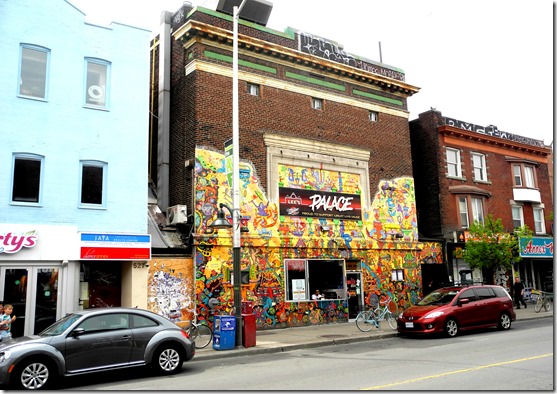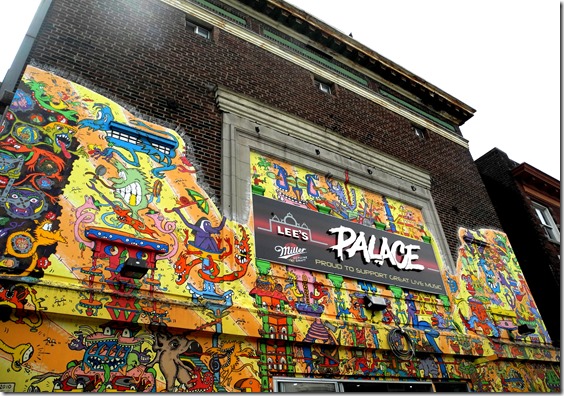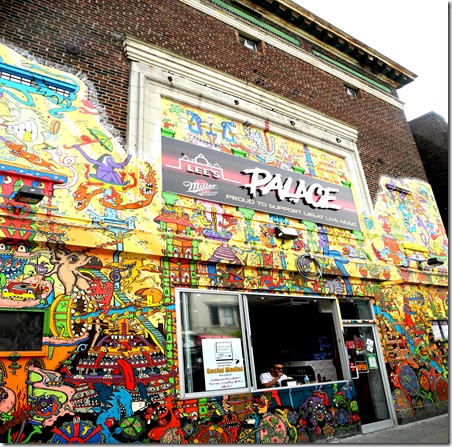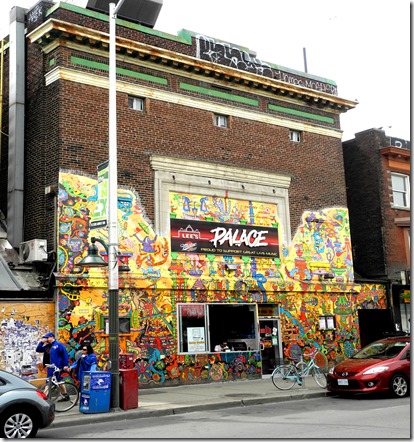Site of the Allen Bloor Theatre, with its colourful graffiti art, at 529 Bloor Street West. Photo taken in 2014.
On a hot summer afternoon in 2014, I journeyed to the intersection of Bloor and Bathurst Streets in search of one of Toronto’s old movie houses. I had never attended the theatre and did not remember it from when I worked in the area in the 1950s. However, I had read about the Allen brothers, Jule and Jay, who had built the theatre.
The Allens opened their first “moving picture theatre” in their home town of Brantford in 1907. They arrived in Toronto in 1915 and in the years ahead, built a chain of theatres that were among the finest in Toronto. They eventually included the Allen Theatre (later renamed the Tivoli), Allen’s Danforth, Allen’s Parkdale, the Beaver, St. Clair, College and the Beach. The exterior of their theatres were often relatively plain, but the interiors were richly ornamented, the exuberant plaster ornamentations and gold-painted trim portraying hints of the cathedrals and palaces of Europe.
In the first decade of the 20th century, the Bloor/Bathurst district was under intense development, a much sought-after residential area. It was not far from downtown Toronto and was serviced by the Bloor and Bathurst streetcar lines. Because it was densely populated, with much pedestrian traffic, it was an ideal location for a movie theatre. The first theatre opened in the area in 1913.
The site of Allen’s Bloor Theatre
In July 2014, I finally arrived at location of the former Allen’s Bloor Theatre. It was at 529 Bloor Street West, on the south side of the street, not far to the east of the intersection of Bloor and Bathurst. However, few traces remained of the luxurious theatre that had been on the site. Now named Lee’s Palace, it was a nightclub and dance hall, offering live performances. Its facade was covered with colourful graffiti art.
The Allen’s Bloor Theatre opened on March 10, 1919 with the silent film “Don’t Change Your Wife,” starring Gloria Swanson. It was one of a series of three films with a similar theme, all starring Gloria Swanson. The theatre was in direct competition with the Madison that had opened in 1913, further west along the street. Allen’s Bloor was the smallest of the Allen theatres, with about 700 seats, as opposed to other Allen venues that were 1200-1500 seats.
Its marquee was small, with three windows above it, topped with Roman arches. Windows of similar design were on opposite sides of them. These small touches, along with the dentils in the cornice, provided classical touches to the facade. The architect of Allen’s Bloor was C. Howard Crane of Detroit, who designed all the Allen venues. Its auditorium contained a stage for vaudeville and an orchestra pit for the musicians. Over the stage area was an enormous archway, with decorative plaster ornamentations surrounding it. The vaulted ceiling resembled a great cathedral.
The theatre was highly successful, but unfortunately the Allen brothers over-extended their finances. In 1923, the chain was purchased by Famous Players, who renamed it the Bloor Theatre.
The Bloor remained an active theatre until the 1950s. After it closed, the premises were renovated for other purposes. It was the Blue Orchid Restaurant for a few years and also a bank. In 1985 it became Lee’s Palace and today is one of the city’s popular live theatre and dance venues.
Note: I am indebted to cinematreasures.org and torontodreamsproject.blogspot.com for the historic photos in this post and to silenttoronto.org by Eric Viellete for some of the information. The colour photographs are my own.
Allen’s Bloor Theatre c. 1920.
Stage and screen of Allen’s Bloor in 1920.
Upper portion of the facade of the old theatre in 2014.
Lee’s Palace in 2014.
Site of Allen’s Bloor Theatre in the summer of 2014.
To view the Home Page for this blog: https://tayloronhistory.com/
To view previous blogs about movie houses of Toronto—historic and modern
Recent publication entitled “Toronto’s Theatres and the Golden Age of the Silver Screen,” by the author of this blog. The publication explores 50 of Toronto’s old theatres and contains over 80 archival photographs of the facades, marquees and interiors of the theatres. It relates anecdotes and stories of the author and others who experienced these grand old movie houses.
To place an order for this book:
Book also available in Chapter/Indigo, the Bell Lightbox Book Store and by phoning University of Toronto Press, Distribution: 416-667-7791
Theatres Included in the Book:
Chapter One – The Early Years—Nickelodeons and the First Theatres in Toronto
Theatorium (Red Mill) Theatre—Toronto’s First Movie Experience and First Permanent Movie Theatre, Auditorium (Avenue, PIckford), Colonial Theatre (the Bay), the Photodome, Revue Theatre, Picture Palace (Royal George), Big Nickel (National, Rio), Madison Theatre (Midtown, Capri, Eden, Bloor Cinema, Bloor Street Hot Docs), Theatre Without a Name (Pastime, Prince Edward, Fox)
Chapter Two – The Great Movie Palaces – The End of the Nickelodeons
Loew’s Yonge Street (Elgin/Winter Garden), Shea’s Hippodrome, The Allen (Tivoli), Pantages (Imperial, Imperial Six, Ed Mirvish), Loew’s Uptown
Chapter Three – Smaller Theatres in the pre-1920s and 1920s
Oakwood, Broadway, Carlton on Parliament Street, Victory on Yonge Street (Embassy, Astor, Showcase, Federal, New Yorker, Panasonic), Allan’s Danforth (Century, Titania, Music Hall), Parkdale, Alhambra (Baronet, Eve), St. Clair, Standard (Strand, Victory, Golden Harvest), Palace, Bedford (Park), Hudson (Mount Pleasant), Belsize (Crest, Regent), Runnymede
Chapter Four – Theatres During the 1930s, the Great Depression
Grant ,Hollywood, Oriole (Cinema, International Cinema), Eglinton, Casino, Radio City, Paramount, Scarboro, Paradise (Eve’s Paradise), State (Bloordale), Colony, Bellevue (Lux, Elektra, Lido), Kingsway, Pylon (Royal, Golden Princess), Metro
Chapter Five – Theatres in the 1940s – The Second World War and the Post-War Years
University, Odeon Fairlawn, Vaughan, Odeon Danforth, Glendale, Odeon Hyland, Nortown, Willow, Downtown, Odeon Carlton, Donlands, Biltmore, Odeon Humber, Town Cinema
Chapter Six – The 1950s Theatres
Savoy (Coronet), Westwood
Chapter Seven – Cineplex and Multi-screen Complexes
Cineplex Eaton Centre, Cineplex Odeon Varsity, Scotiabank Cineplex, Dundas Square Cineplex, The Bell Lightbox (TIFF)

![large[1] large[1]](https://tayloronhistory.com/wp-content/uploads/2015/01/large1_thumb.jpg)
![LeesPalace-AllensBloorTheatre-1919[1] LeesPalace-AllensBloorTheatre-1919[1]](https://tayloronhistory.com/wp-content/uploads/2015/01/leespalace-allensbloortheatre-19191_thumb.jpg)



![cid_E474E4F9-11FC-42C9-AAAD-1B66D852[1] cid_E474E4F9-11FC-42C9-AAAD-1B66D852[1]](https://tayloronhistory.com/wp-content/uploads/2015/01/cid_e474e4f9-11fc-42c9-aaad-1b66d8521_thumb1.jpg)

